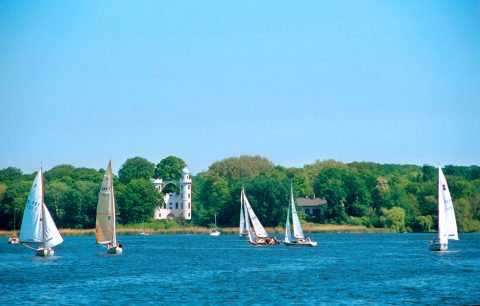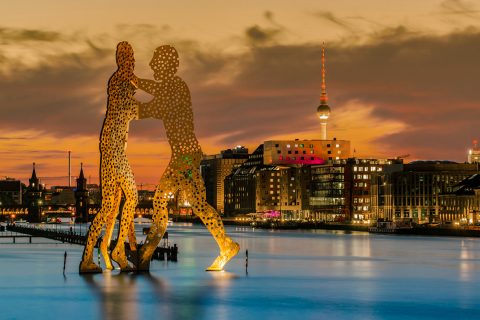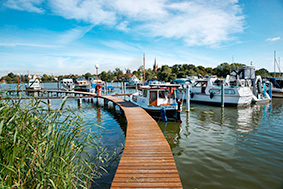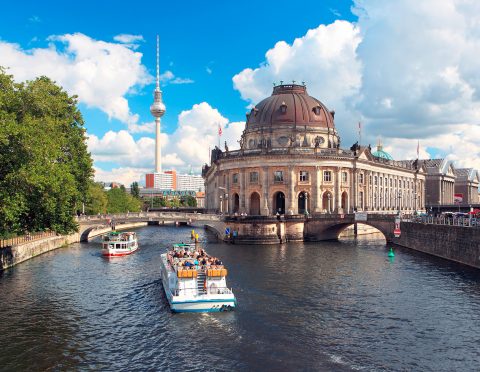Brandenburg and Berlin waters
Ideal cruising grounds in Berlin and Brandenburg
A diverting mix of boating, sightseeing and cultural activities awaits the yachter in Germany’s capital Berlin and in the adjoining cruising grounds on the Potsdam Havel and the Brandenburg Havel lakes.
Exploring Berlin along the river Spree or one of the many canals is always a highlight – on your own keel or in a chartered boat. There will be opportunity to take a peek into the German President’s garden or a water-side view of the Federal Chancellery. There is no shortage of quiet and picturesque waterways to enjoy at the pace of leisure in the German metropolis though.
Skippers experiencing Berlin via its waterways for the first time will be greatly impressed by this extensive, enchanting and interesting riverine landscape. Unspoiled nature, the pulsating rhythm of a capital city and historical points of interest – all to be enjoyed while gliding by.
The Havel lakes and the river Dahme
Enjoy idyllic landscapes of reedy shores on spacious lakes and romantically meandering riverways, explore grand palaces and gardens such as Charlottenburg and Sanssouci on the banks of the river Havel and see the historic towns and cities of Brandenburg. The Potsdam and Brandenburg Havel lakes offer the perfect mix for a holiday. Art and culture aficionados should allow enough time for onshore visits.
In the south-eastern corner of Brandenburg, the Müggelspree and Dahme rivers entice yachters the Königs Wusterhausen way to visit the palace of King Frederick William I of Prussia and enjoy the lovely nature surrounding beautiful anchorages along quiet riverbanks.
To the Federal Chancellery by boat
Sail the Spree starting at Spandau and through the Government District and on via the river Dahme to Müggelsee, the largest of the Berlin lakes.
City cruising on the river Spree. The Havel and Spree – the latter part of the Spree-Oder waterway (SOW) – meet to the south of the Spandau Citadel.
Continuing upriver, the cruise takes you into the heart of Berlin, passing Charlottenburg palace to starboard. The palace and gardens can be reached on foot from the Charlottenburger Ufer pleasure craft berthing (see. no. 17). Approaching the Government District (shortwave radio communications mandatory) the landmarks soon start piling up: Bellevue Palace, the residence of the German Federal President, the Chancellery, the Humboldt Harbour, the Reichstag building, the Schiffbauerdamm riverside with a pleasure craft berthing (see. no. 20), the Museum Island, the Berlin Cathedral, the site of the Berlin Palace and the Red City Hall on the fringe of the Nikolaiviertel section of old-town Berlin. It is within easy walking distance from the Wallstraße pleasure craft berthing (see no. 21) in the Spree canal (Spreekanal, SpK) just after the Mühlendammschleuse locks. After the Spreekanal branch-off the Spree becomes wider. Passing under the neo-gothic Oberbaumbrücke bridge you continue past the Badeschiff swimming baths top the 30m tall Molecule Man sculpture. Upriver on the left bank of the Spree you will find another pleasure craft berthing (see no. 22) opposite the Insel der Jugend island and a take-off for seaplanes. At kilometre 26.3 of the SOW, the Britzer Verbindungskanal (BVK) connecting canal branches off to the south towards the Teltow canal (Teltowkanal, TeK). The latter can be used to sail around the inner city towards Potsdam. At kilometre 28.3 of the TeK, at the Britz-Ost harbour, near the motorway bridge, the Neukölln canal (Neuköllner Schifffahrtskanal, NK) branches off to starboard. The Neukölln-Unterhafen unattended lock gives access to the Landwehr canal (Landwehrkanal, LWK) which you can use as you route back to your starting point at Spandau.
The Köpenick circuit
This is a one-day cruise (appox. 25km) starting at the Köpenick Palace via the lakes Dämeritzsee, Müggelspree (MgS) and Großer Müggelsee back to Berlin. Take the river Dahme from Köpenick to lake Langer See, which is an ideal sailing ground. The Müggelberge hills (up to 114.7m) rise to port. At kilometre 44 of the SOW you head on a north-easterly course into lake Seddinsee, also a sailing favourite. This is the starting point of charter cruising grounds. Then head towards lake Dämeritzsee via the Gosen canal (Gosener Kanal, GoK).
To the east of the Gosener Kanal lies the vastest nature reserve in Berlin. It provides protection to rare ferns and flowering plants and refuge to a variety of animal species, including sea eagles, cranes and the rare corn crake.
Via lake Dämeritzsee near Erkner you can join the Rüdersdorfer Gewässer (RüG) waterway to the north. Due to low water depths, the Müggelspree section east of the Dämeritzsee is accessible only to low-draught pleasure craft. Sailing out of the western end of lake Dämeritzsee, the cruise continues via the Müggelspree, past the Neu Venedig (New Venice) canals of Wilhelmshagen into Kleiner and Großer Müggelsee. Due to the low water depths in the New Venice canals (0.5m) and low bridges, we recommend not to enter these canals. The wooded banks of the canals are lined with holiday cottages and grand villas. The Großer Müggelsee is a lake popular among the sailing crowd. Power boats must not leave the buoyed channel. At the Baumgarteninsel (Orchard Island) at Köpenick, the Müggelspree meets the SOW. Navigating to port, you reach the Köpenick Palace again, and to starboard downtown Berlin via the Alte Spree.
From lake Seddinsee into the hinterlands
You have the option of a southern stint from Schmöckwitz on lake Seddinsee into lake Zeuthener See. The Notte river section of the Dahme-Wasserstraße (DaW) waterway then takes you to Königs Wusterhausen. On the main course of the river Dahme, you can pass through the Neue Mühle lock into the Krimnick and lake Krüpelsee charter cruising grounds. A shorter option is the circuit from lake Zeuthener See via the Großer Zug and Krossinsee lakes to the Steinfurt lock at Wernsdorf. This is where you take the SOW in a west-north-westerly direction back to Berlin via lake Seddinsee.
Berlin and the Spree, Havel and Dahme rivers
Lively city cruise and quiet outdoors between lake Wannsee, Köpenick and the Wernsdorf waterways
Eleven navigable waterways running to almost 200km crisscross Berlin. The Spree stretches 46km from lake Dämeritzsee near Erkner and its confluence with the Havel at Spandau. Two locks, one at Charlottenburg and the Mühlendammschleuse, must be negotiated. The lowest bridge (4.0m) waits at kilometre 18.2. Lake Wannsee and lake Tegeler See in the west, jointly stretching to 6.7km2, and the 7.5km2 Großer Müggelsee in the east are popular sailing grounds.
The Berlin canals include the Berlin-Spandauer Schifffahrtskanal (BSK), Westhafenkanal, Charlottenburger Verbindungskanal and the Britzer Verbindungskanal (BVK), the latter two being connecting canals, jointly stretching to 22km of waterways. A bridge in Tegel (at kilometre 30.8) giving only 3.63m clearance and a lock at Plötzensee must be negotiated on these canals. More important is the 10.9km Landwehrkanal (LWK), crossed by the lowest bridge (3.3m) at Kreuzberg at kilometre 5.6. Its water depth is regulated by the Unterschleuse and Oberschleuse (lower and upper locks). Further to the south, the Teltowkanal (TeK) skirts the Berlin city on a length of 38km. The lock at Kleinmachnow and the 3.69m Böckmannbrücke bridge at lake Griebnitzsee must be negotiated here. The 4km Neuköllner Schifffahrtskanal (NK) is regulated by only one lock. The lowest bridge here (2.71m) awaits at kilometre 3.61.
To the south-east, some very attractive cruising is available on lake Müggelsee and lake Dämeritzsee and the river Dahme. With the Wernsdorf chain of lakes, lake Möllenzugsee including the Krüpelsee charter cruising ground and lake Zernsdorfere Lanke, the river forms the Dahme Wasserstraße (DaW) waterway starting at Eichwalde.
Free 24h pleasure craft berthing – without freshwater and power facilities – is available at public moorings Lines must not be fastened to rescue ladders. Nine out of the 14 berths are equpped as ADAC info points. Boards displaying map sections indicate phone and emergency calling numbers, doctors’ offices and hospitals nearby, transport connections, POI, pharmacies, supermarkets, locks and boat filling stations.
Brandenburg and the Potsdam Havel
The Havelland awaits yachters with some 180km of riverine waterways, over 40 lakes, canals and meandering river arms
The Potsdam Havel (PHv) is a 28.6km V- or rather Y-shaped secondary route on the Untere Havel-Wasserstraße (UHW) – the Lower Havel Waterway. It appears as a chain of large, often shallow lakes linked by short river sections. The kilometre marking does not follow the customary pattern in the direction of flow. The counting of waterway kilometres on the PHv goes against the direction of flow, i.e. upriver. Its kilometre zero is at lake Göttinsee and it joins the UHW in lake Jungfernsee near the famous Bridge of Spies at Glienicke and the Teltowkanal (TeK). This is where the main stretch of the UHW begins – the shortest connection between Potsdam via lake Fahrlander See to lake Göttinsee.
Maximum speed on the river sections of the PHv is 12kph (25kph on the lakes and where the waterway is at least 250m wide and allows a minimum distance of 100m from the banks).
The lowest bridge clearance is 5.08m in Werder, 5.32m at the Lange Brücke (Long Bridge) in the Potsdam Neue Fahrt branch and 5.20m at the Eisenbahnbrücke (railway bridge). In the Alte Fahrt branch, the clearance of a pedestrian bridge is only 3.02m. Water depths vary between 90cm and 140cm.
The Untere Havel-Wasserstraße joins Berlin-Spandau with lake Jungfernsee. Then its main course follows the Sacrow-Paretz canal (Sacrow-Paretzer Kanal, SPK) into lake Göttinsee where it meets the Havel again. The UHW heads towards Havelsberg via the towns of Ketzin, Brandenburg an der Havel and Rathenow. Finally, the Elbe-Havel-Verbindungskanal joins it to the river Elbe at kilometre 148.43. The maximum speeds are like those on the river section of the PHv.
After the confluence of the PHv with the main course of the UHW, the Mittlere Havel (Middle Havel) is defined by extensive lakes, short-cut canals and renatured river sections downriver of Ketzin, meandering loops, cut-throughs and islands.
The 34.6km Havel canal (Havelkanal, HvK) links lake Göttinsee to lake Nieder Neuendorfer See south of Henningsdorf. Featuring only one lock at Schönwalde, the HvK is a convenient belt waterway to bypass Potsdam and Berlin. And it is the shortest connection between the UHW and the Oder-Havel canal (Oder-Havel-Kanal). Maximum speed on the HvK is 9kph (less in some places). Water depth is 2.5m. The lowest bridge clearance is 4.5m.
Cruising Theodor Fontane’s “Blue Havel”
The riparian kingdom of the Havel joins Berlin to Potsdam, the Brandenburg Havel lakes, the island town of Werder and Rathenow.
The 19th century poet and novelist Theodor Fontane, himself a Brandenburg native, once described the region around Werder, Töplitz and Caputh: “Blue Havel and yellow sand, black of hat and brown of hand, fresh of heart and hearty air and cherries sweet as girls’ lips fair.”
A cruise from Spandau to Rathenow, depending on the route you chose, will be between 92 and 103km long, with only three locks to negotiate (Vorstadtschleuse Rathenow, Bahnitz, Vorstadtschleuse Brandenburg). The lowest clearance of 4.58m is encountered at Bahnitz.
From Spandau to Pfaueninsel
To the south of Spandau, starting at kilometre 4 of the Untere Havel-Wasserstraße (UHW), the Havel gets wider and dotted with many islands such as Lindwerder, Schwanenwerder and Kälberwerder. Idyllic bathing coves overlooked by wooded hills provide the backdrop and frame to this landscape. Topping the trees is the 56m Grunewald tower, a popular destination for outings. The next landmark is Pfaueninsel – Peacock Island – a 67ha park with its picturesque castle – now a UNESCO World Heritage Site. There is no anchorage for pleasure craft. Southbound along the Kladower Seestrecke (Kladow String of Lakes), past the Heilandskirche (Church of our Saviour) at Sacrow to starboard you reach the Potsdam Havel near the Glienicke Bridge.
Heading out to lake Wannsee
A variant route offers itself just after the Schwanenwerder island at kilometre 11 of the UHW, before you even reach Peacock Island. At this point, the Große Wannsee opens to port. This is where Berliners and tourists alike go bathing in the lakeside spa immortalised in a popular 1950s song. The circuit cruise variant of some kilometres takes you in a clockwise direction through the Kleine Wannsee with its impressive shoreside architecture to the Pohlesee and Stölpchensee lakes. Via the Griebnitz canal (Griebnitzkanal), a.k.a. Prinz-Friedrich-Leopold-Kanal (PFLK), you reach lake Griebnitzsee. This is where the Teltowkanal (TeK) sheds coming from Berlin. Past Babelsberg Palace and its park to port we follow the Teltow canal to Tiefe See (Deep Lake), at the end of which, again at the Glienicke Bridge we join the tail end of the Potsdam Havel at kilometre 28.3.
To the south, the next destination is Potsdam, the capiutal of the Land of Brandenburg with a great many points of interest. Its special highlights are Sanssouci Palace and Cäcilienhof Palace.
To Werder an der Havel
The direct route to Brandenburg/Havel skips Potsdam favouring the main course of the UHW, the Sacrow-Paretzer Kanal (SPK).
The longer and also more beautiful route south via the Potsdam Havel is a must for pleasure boaters, nevertheless. Here you avoid commercial traffic but must be prepared to share the waterway with plenty of other pleasure craft and tourist steamers. The Potsdam Havel is followed to the south by a route along the Tiefe See into Templin lake. On the shores of the latter Albert Einstein had his summer house. This leg of the cruise continues past Caputh and the baroque country mansion of Frederick William, Elector of Brandenburg, a.k.a. the Great Elector, and negotiates the narrow Caputher Gemünde to reach lake Schwielowsee. Then you take course towards Werder upon Havel and lake Großer Zernsee. The traditional fruit and wine growing region around the town attracts many tourists – and not only in springtime when the trees are in bloom Many places make an extensive onshore exploration worthwhile. For instance the island town of Werder itself, where the spire of the Heilig-Geist-Kirche (Church of the Holy Spirit) seems to pierce the sky. The novelist and Brandenburg hiker Theodor Fontane described the church as a “small-town cathedral”. This leg offers numerous landing and provisioning opportunities. Moreover, the lake-like salients along the river Havel are ideal sailing grounds offering quiet, idyllic bays for anchoring.
To Brandenburg town
At the north-western end of lake Zernsee, near the Zernsee motorway bridge (approx. 10m clearance), two ADAC ADAC nautical bases are located: Ringel and Zernsee. If the lakeshores you passed so far were lined mostly by mansions and historical landmarks, you will now navigate a more rural scenery dominated by fishing villages. The Havel slowly meanders by. This way you get to the town of Brandenburg an der Havel without the bother of bridges and locks. But first you reach lake Göttinsee, the meeting point of the UHW coming from the west and the Havel canal coming from the north. For charterers it is now time to head back because this is were the Potsdam Havel charter cruising ground ends. To proceed downriver to Ketzin and lake Trebelsee, skippers must hold a certificate for operators of pleasure craft/inland waters.
The route to Brandenburg/Havel follows the river through the Osthavelniederung (Eastern Havel Bottomlands). Before reaching the town, the skipper has a choice of two waterways to follow. Along the Brandenburger Stadtkanal (Brandenburg Town Canal) and Niederhavel (Brandenburg Lower Havel) you sail into and across town. To navigate the latter, your boat needs to be equipped with an on-water foldaway mast. To the north you can use the Silo canal (Silokanal) to sail around downtown. To reach it, you need to negotiate the Vorstadtschleuse lock. Its official name is Schleuse Brandenburg (Brandenburg Lock). On a northern heading, the canal flows into the long and and winding dead-end chain of the Beetzen lakes (Beetzseen), which is hardly ever sailed. This is another charter cruising ground ending in the NE. Lying to the West of town, the Havel lakes (Breitlingsee, Möschener and Plauer See) are popular among sailors and charter skippers.
Rathenow
On a northerly course, we cruise from lake Plauer See across the Havelland region to Rathenow. This is where the river Havel splits into four arms embracing the small historic town. Here is one of the cradles of optical manufacturing as documented in the Optik-Industrie-Museum (Optical Industry Museum). In its Böhne district we meet the novelist and poet Theodor Fontane again. As Baroness von Ardenne, one of the prototypes of his heroine Effi Briest lived here in the “Schwedenhaus”, a half-timber estate administrator’s residence, for a few years.
ADAC nautical bases
At the gates of Berlin
You can recognise the marinas by the ADAC nautical tourism flag and a sign reading ADAC Stützpunkt (nautical tourism base).
The Yachthafen Ringel marina is the ADAC nautical base in Töplitz, a district of the town of Werder. It is situated to the south-east of the A10 motorway bridge across the Havel at river kilometre 7. At this marina, 210 berths are available at jetties with mooring fingers and a number of dry berths. In addition to a Diesel pump, the technical facilities include a black water pump-out station and a hoist. Food and drink are available at a restaurant. The berthing fee includes freshwater and showers. Electricity is charged separately.
Marina Zernsee is an ADAC nautical base located in Werder proper. In a natural bay on the western shore of lake Zernsee, 160 berths are available at jetties with mooring fingers. The mooring fees include freshwater, sanitary facilities, and electricity.
Restrictions and traffic rules
The Spreekanal and Spree-Oder-Wasserstraße (SOW) are closed to unpowered small craft and powered craft under 5hp (3.69kW) between the Kanzleramtssteg (Chancellery pier) and Oberbaumbrücke bridge (kilometres 14.1 to 20.7). For powerboats under 15hp (11.03kW) a certificate for operators of pleasure craft/inland waters is required.
The Government District section of the SOW between Lessingbrücke bridge and the Mühlendamm lock (kilometres 12.01 to 17.8) is open to FM radio equipped craft from 1 April to 31 October between 10:30 and 19:00hrs. One crew member must hold a valid radio operator’s certificate. Boats not equipped accordingly must have entered the Mühlendamm lock by 10:30hrs.
The Berlin-Spandau canal (Berlin-Spandauer-Schifffahrtskanal, BSK) is closed to pleasure craft between the Westhafen harbour and its juncture with the SOW (kilometres 8.35 to 12.2).
The Landwehrkanal (LWK) is closed to pleasure craft with 5hp and above in the upriver direction (from Unterschleuse to Oberschleuse locks). Unpowered craft and craft with less than 5hp must not exceed the speed limit of 6kph.
On lake Große Müggelsee, pleasure craft sailing under power from an internal combustion engine are restricted to the navigation channel. The Gosen canal (Gosener Graben, GoG) is closed to craft running under engine power. Pleasure craft over 2m wide are restricted to using the Griebnitz canal (Griebnitzkanal, GrK) between Teltowkanal and lake Stölpchensee sailing downriver to max. 20 minutes after the hour and upriver to 20 minutes after the half hour.
The certificate for operators of pleasure craft/inland waters under sail is required on all federal waterways within the Land of Berlin (with the exception of Zeuthener See und Dämeritzsee lakes) for pleasure craft with a sail surface exceeding 3m2. This requirement also applies to the Untere Havel-Wasserstraße (UHW) between the northern tip of the Pfaueninsel island and kilometre 16.4 and the Havel-Oder-Wasserstraße (HOW) between kilometres 6.4 and 10.2 including lake Nieder Neuendorfer See in the Land of Brandenburg.
A ban on sailing is in force on the Berlin and Brandenburg waterways listed below: the SOW between the mouth of the River Spree and Stralau (kilometres 0.15 to 23.50), the Müggelspree river section from the eastern shore of lake Großer Müggelsee to the western end of lake Dämeritzsee (kilometres 7.0 to 11.39), the UHW between the mouth of the river Spree and the Pichelsdorfer Gmünd (kilometres 0.0 to 4.0), the Dahme-Wasserstraße (DaW) from the southern end of lake Möllenzugsee to the northern end of lake Kemnicksee (kilometres 7.0 to 10.30), the Notte, the HOW excepting kilometres 1.0 to 10.58.
A night-time ban for pleasure craft sailing under power from an internal combustion engine is in force between 22:00hrs and 5:00hrs on the lakes listed below: Kleiner Müggelsee, Die Bänke, Große Krampe, Kalksee, Zernsdorfer Lanke, Scharfe Lanke and Sacrower Lanke, Petziensee, Glindowsee, Lehnitzsee and Kampnitzsee, Tegeler See, Nieder Neuendorfer See (from kilometre 10.0) and Werbellinsee. Permanent/long-term berthing may be accessed on the shortest route.
How, where, what: Emergency phone numbers and addresses for a carefree cruise
Service and information:
Emergency phone number 112
Roadside assistance:
ADAC assistance centre, Munich
Phone: +49 89 22 22 22
Water police
Berlin, phone: +49 30 46 64 75 10 13
Oranienburg, phone: +49 33 01 85 003
Brandenburg, phone: +49 33 36 85 390
Potsdam, phone: +49 33 19 68 84 24
Water and shipping authority
www.wsa-berlin.wsv.de (in German)
www.wsa-brandenburg.wsv.de (in German)
Locks, bridges berthing, traffic information, water levels on federal waterways
www.elwis.de (in German)
www.pegelonline.wsv.de (in German)
Waterways of the Land of Brandenburg
www.lbv.brandenburg.de/service.htm (in German)
Weather forecasts
Deutscher Wetterdienst (German meteorological service)
www.dwd.de/EN
Wind and wave forecasts
Yacht charter:
The ADAC partner CharterCheck operates a comparison and booking portal for yacht charters to help you find a yacht or houseboat that you can sail without holding a certificate for operators of pleasure craft.





